The enrollment cliff is coming — is your college ready? There is no need to hide under your desk because we have some good news …
Community colleges are much better positioned to navigate the impending enrollment cliff than for-profit four- and two-year colleges! But there is a secret to future enrollment success that requires new ways of thinking.
“The days of recruitment being able to cover the gap of declining high school grads are long gone,” says our CEO, Dr. Diane Walleser. “Colleges need to look at alternative strategies to keep their enrollments healthy. The focus must shift to converting more students from application and overall student success.”
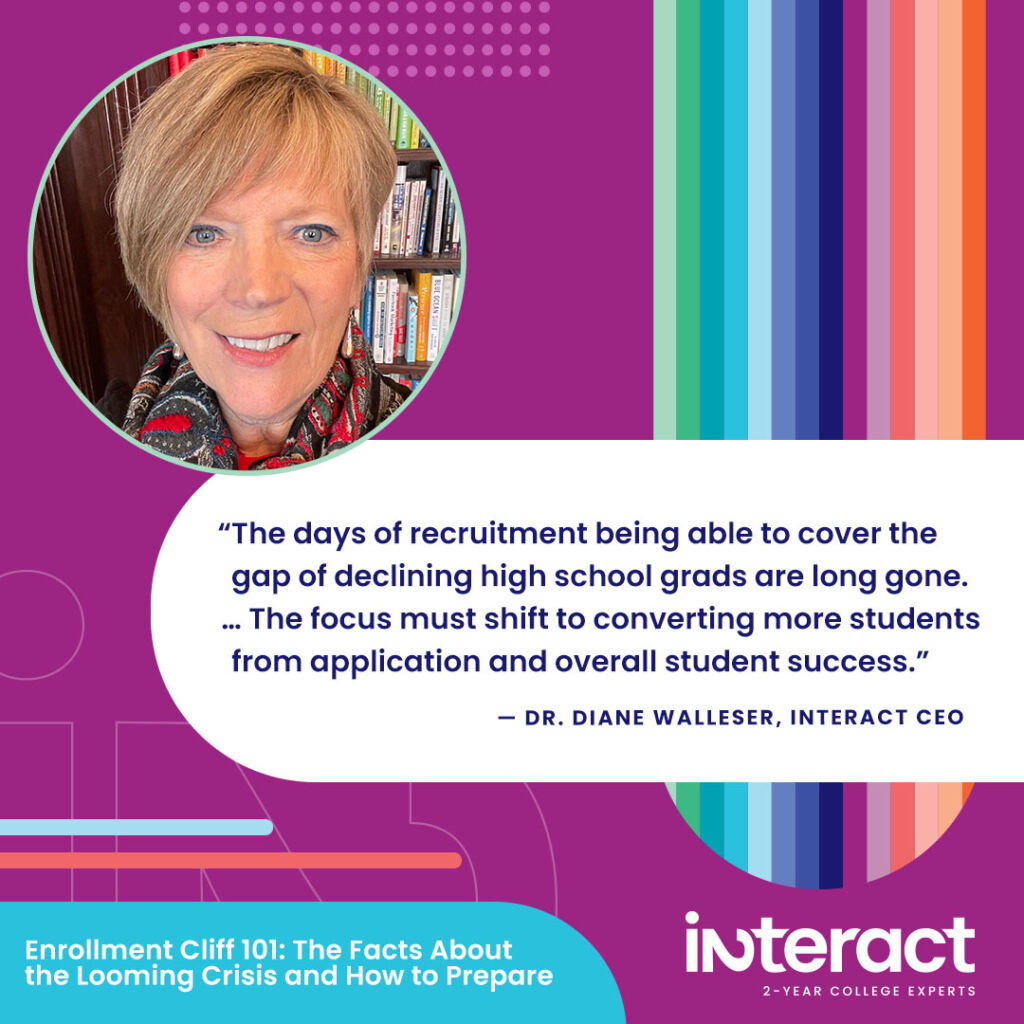
The typical college only converts 40%-60% of applicants, leaving many students in the cold and classroom seats unfilled. Plus, community college completion rates are around 40%, which means too many students are stopping out. That’s why Walleser says that when it comes to the enrollment cliff, we need to start making every student count, especially those you already have. “Focusing on the students within your pipeline will help offset the lower number of entering high school grads.”
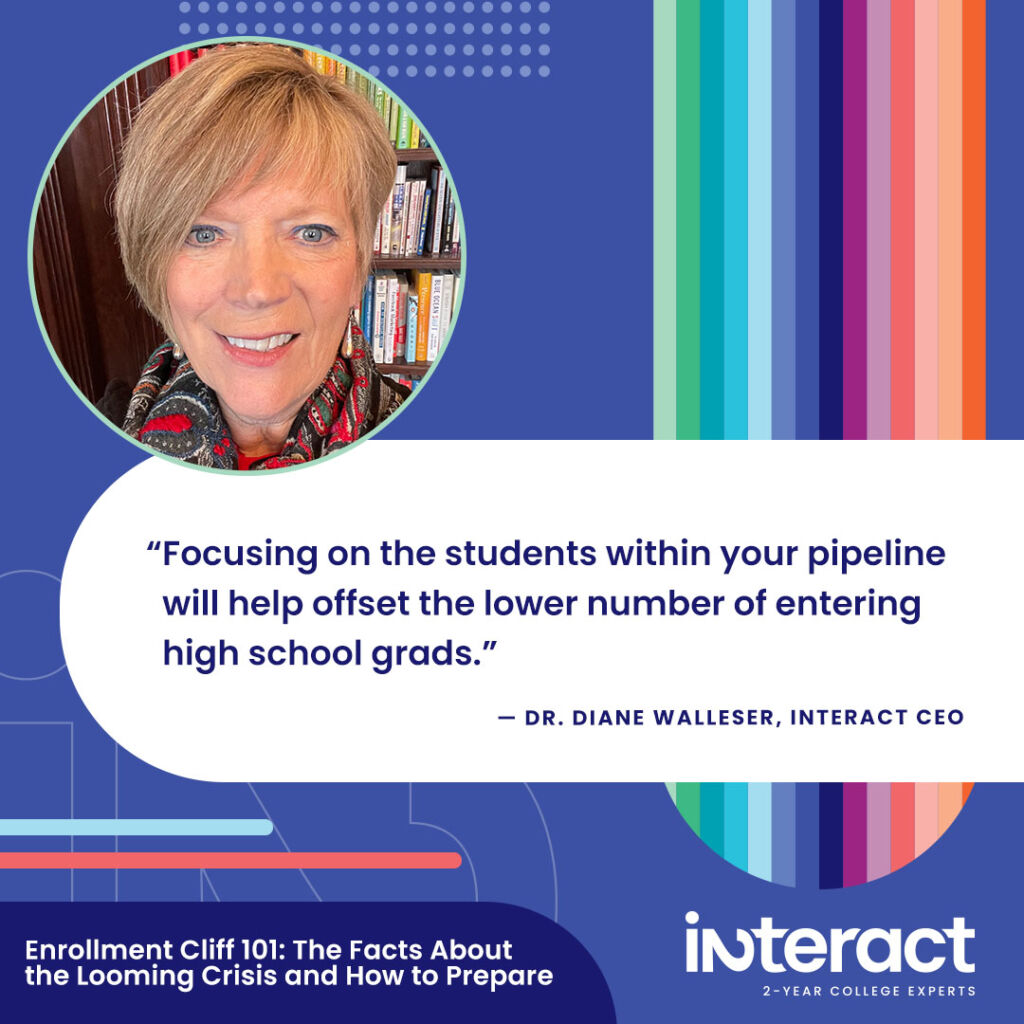
In this blog, find all the facts you need to know about the enrollment cliff and how your college can survive and thrive.
What Is the Enrollment Cliff?
The enrollment cliff refers to a natural tapering off of high-school-aged students. The number of U.S. high school graduates will peak in 2025 before declining due to decreasing birth rates following the 2008 recession.
Between 2025 and 2029, the number of 18-year-olds is projected to decrease by 15%. Nathan Grawe’s Higher Education Demand Index on Synario projects an average loss of 100,000 students per year — over 400,000 fewer students overall.
However, these numbers are nothing new:
“We’ve talked a lot about COVID creating problems in enrollment,” says Interact’s CEO, Dr. Diane Walleser. “However, this demographic downturn has been happening for 10 years, and people have ignored it.”
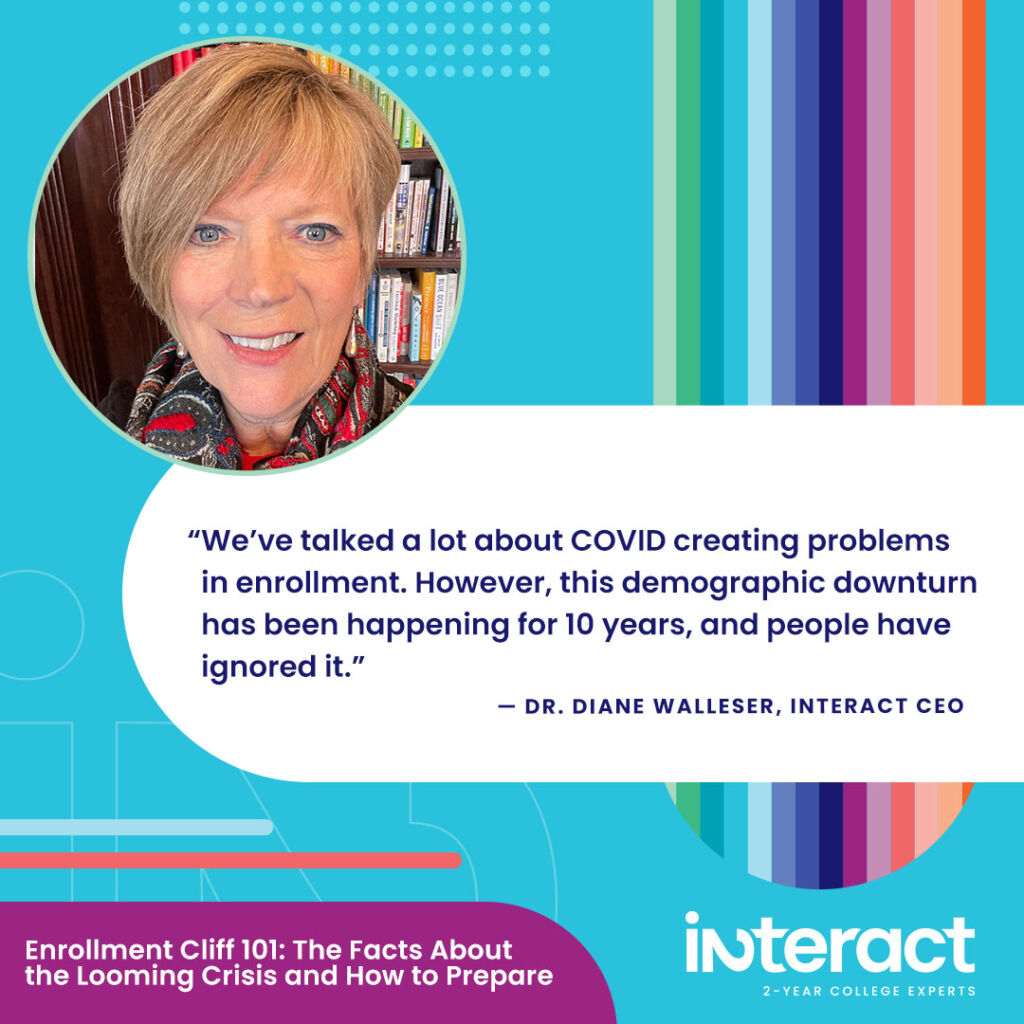
Other factors are also affecting the enrollment cliff. The recent “FASFA fiasco” [link to the previous blog] delayed financial aid offers and acceptances, creating greater friction in the onboarding process. Also consider that college preparedness is down: Only 21% of U.S. high schoolers are well-prepared for college, according to Skills Academia.
But perhaps the most pressing factor is the “demand cliff:”
And Then There Is the “Demand Cliff”: Shifting Attitudes in Higher Education
Significantly, attitudes about higher education are also changing, affecting enrollment rates.
“This isn’t the first time the number of school-age children has dropped — but prior dips dovetailed with an increase in high school graduation and college attendance.
“That’s because more people saw the value of educational attainment.”
From Axios, Schools Are Bracing for the Looming “Enrollment Cliff,” by Jennifer A. Kingson
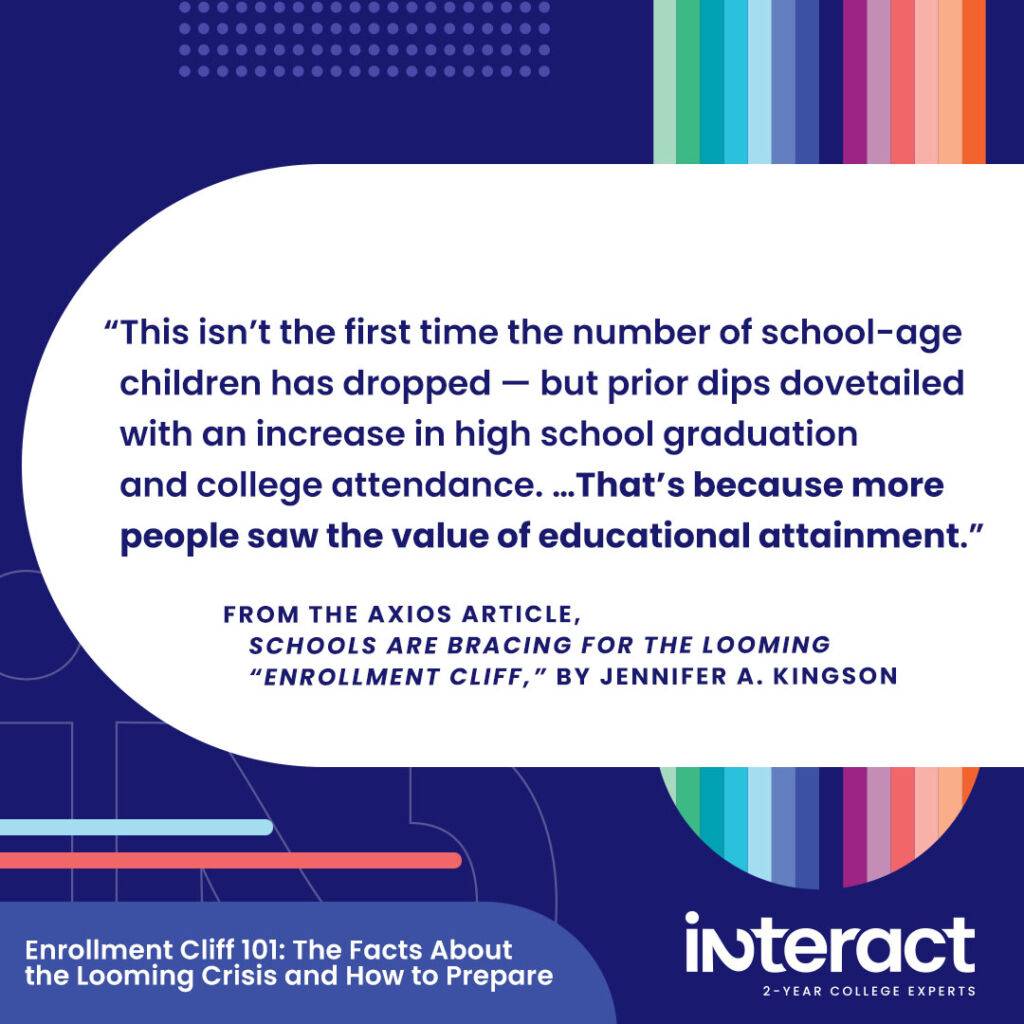
Beyond the much-discussed impending enrollment cliff, student demand is concurrently dwindling. “What is less well-known is that the percentage of 18- to 24-year-olds choosing to attend college reached its peak years ago and continues to decline,” write Rebecca Mathews, Bijan Warner, and Peter Stokes in the Inside Higher Ed opinion piece, Managing the Demand Cliff. They argue that the decline of traditional-age students combined with shifting attitudes about higher ed are “unprecedented.” The authors say it’s time to demonstrate the ROI of a college degree.
“A growing contingent of potential students is bypassing the traditional college experience in favor of immediate entry into the workforce. This shift represents a convergence of demographic trends and changing attitudes toward education. … The price of a degree has continued to rise, while the value of higher education degrees has become popular to question in the open market.”
From Education Dynamics, What is the Enrollment Cliff in 2025? by Jesse Homan
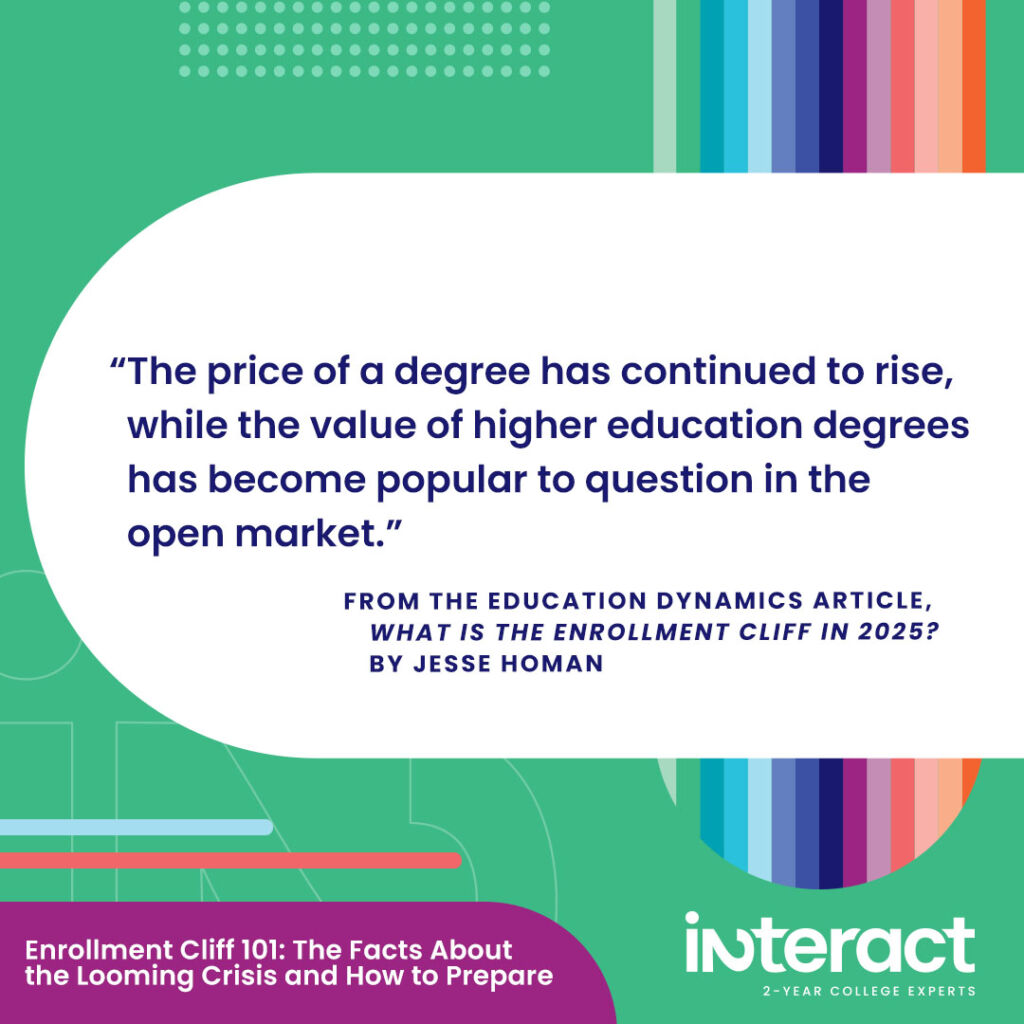
Students are increasingly questioning the value of a degree, especially our Gen Z demographics. As we move into the enrollment cliff era, our colleges must demonstrate their value:
“We’re not helping students understand the ROI,” says Walleser. “We must add more encouragement in our outreach and retention communications.”
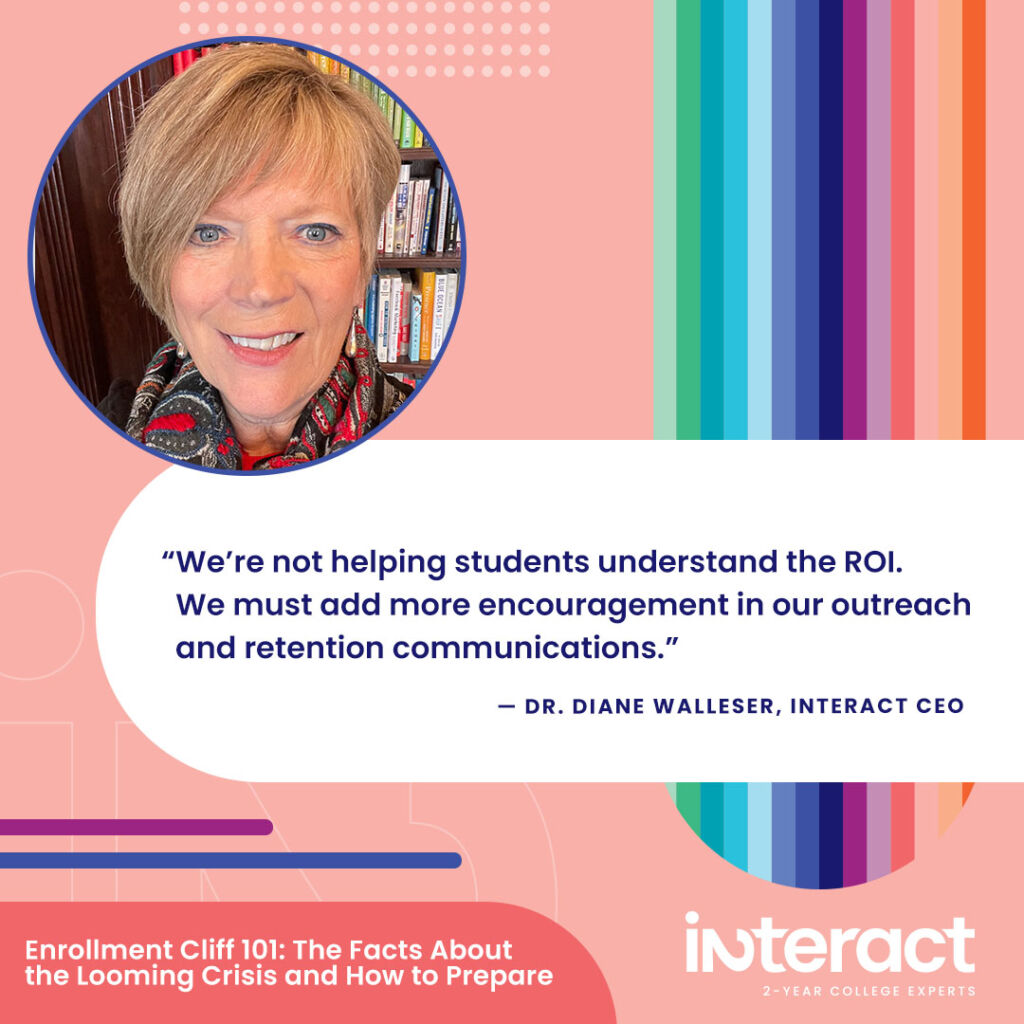
What Impact Is the Enrollment Cliff Already Having on Higher Education?
First off, schools are rapidly closing. According to an April 2024 Hechinger Report, colleges are shutting their doors at an average rate of one per week. That sobering statistic is up from last year’s two colleges a month. Meanwhile, as many as 1 in 10 four-year colleges and universities are in significant financial trouble, according to the consulting firm EY Parthenon.
On top of faculty layoffs and district financial crunches, new competitors are also on the scene. Take Google, which now offers postsecondary programs through Coursera. The tech giant treats these six-month Google Career Certificates focusing on data analytics, project management, and user experience as equivalents to four-year degrees!
And yet, when colleges are flexible, they can turn the competition into cooperation to boost enrollment. Take one of our partners, the North Far North Regional Consortium. Their colleges teamed up, offering students the Google IT Support Professional Certificate at no cost, enhancing the online certificate with on-campus support.
Community colleges are uniquely suited to be flexible and adapt to workforce needs. This makes two-year institutions much more resilient:
Why Are Community Colleges Uniquely Poised to Weather the Enrollment Cliff?
A recent Gallup survey shows that “an increasing proportion of U.S. adults say they have little or no confidence in higher education.” Only one-third of 18-29-year-olds thought a college degree was “worth it” if it necessitated student loans.
However, a separate Gallup-Lumina series reveals that “about half of Americans (48%) say they have a great deal or quite a lot of confidence in community colleges.”
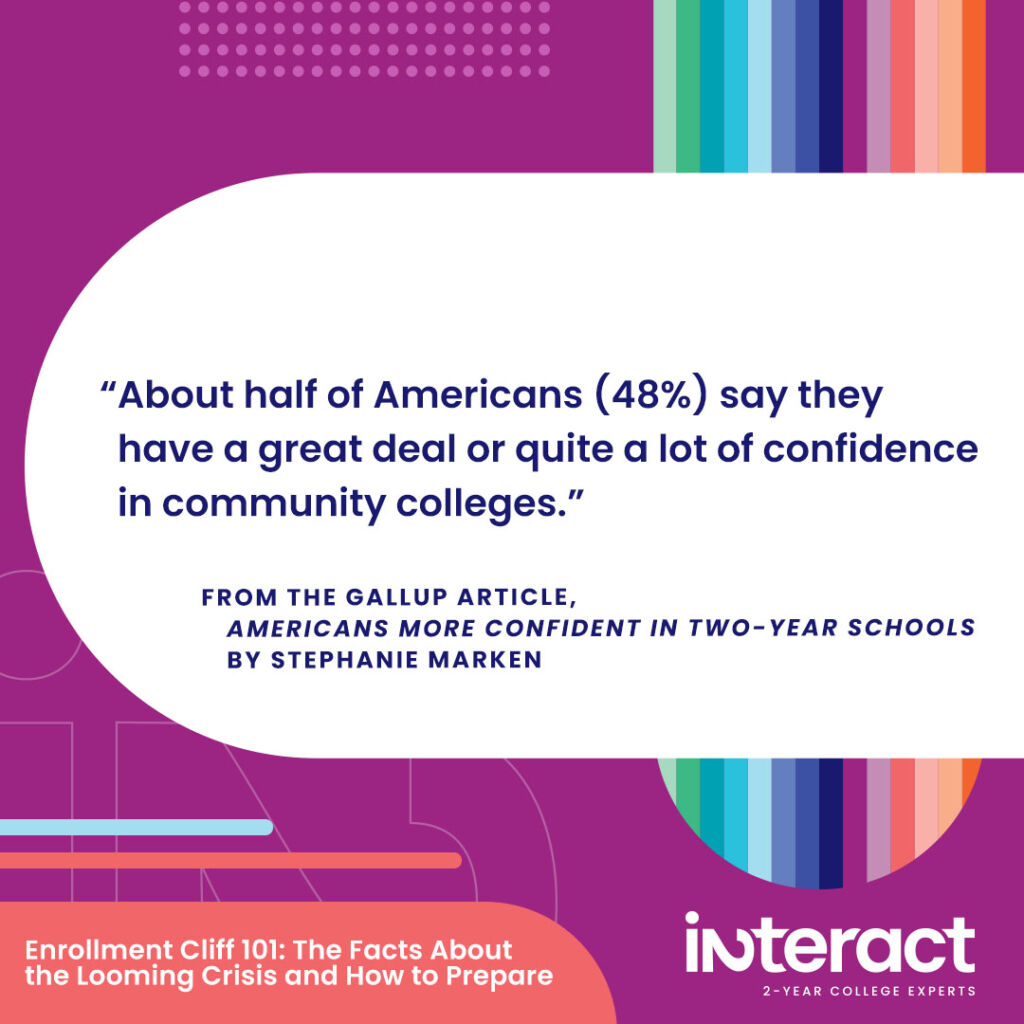
These surveys reveal a lot about the shifting attitudes of our audiences and show the opportunity for community colleges to prove their mettle. Also, keep in mind that prospects are abandoning higher education because of the high price tag. “Most students — especially low-income and historically excluded students — eliminate colleges from consideration based upon the published total cost,” reads the Ellucian article “We’re Facing an Enrollment Cliff. Here’s How We Overcome It.”
But community colleges are and have always been the smart, affordable choice. So, ensuring your audience knows this — especially your historically underrepresented students — is crucial to our outreach and retention efforts.
“With the rising cost of higher education, many students are stepping away from pursuing their dreams, especially those from low-income and historically underrepresented backgrounds,” says Chief Marketing and Business Development Officer Chelsey Bowers. “We believe it’s more important than ever to drive home the message that community colleges are the smart, affordable choice.
“Our outreach and retention efforts must continually emphasize this value proposition while also being proactive in guiding students through the FAFSA process and educating them on how they can afford college. By doing so, we can ensure that more students have access to the transformative opportunities community colleges offer.”
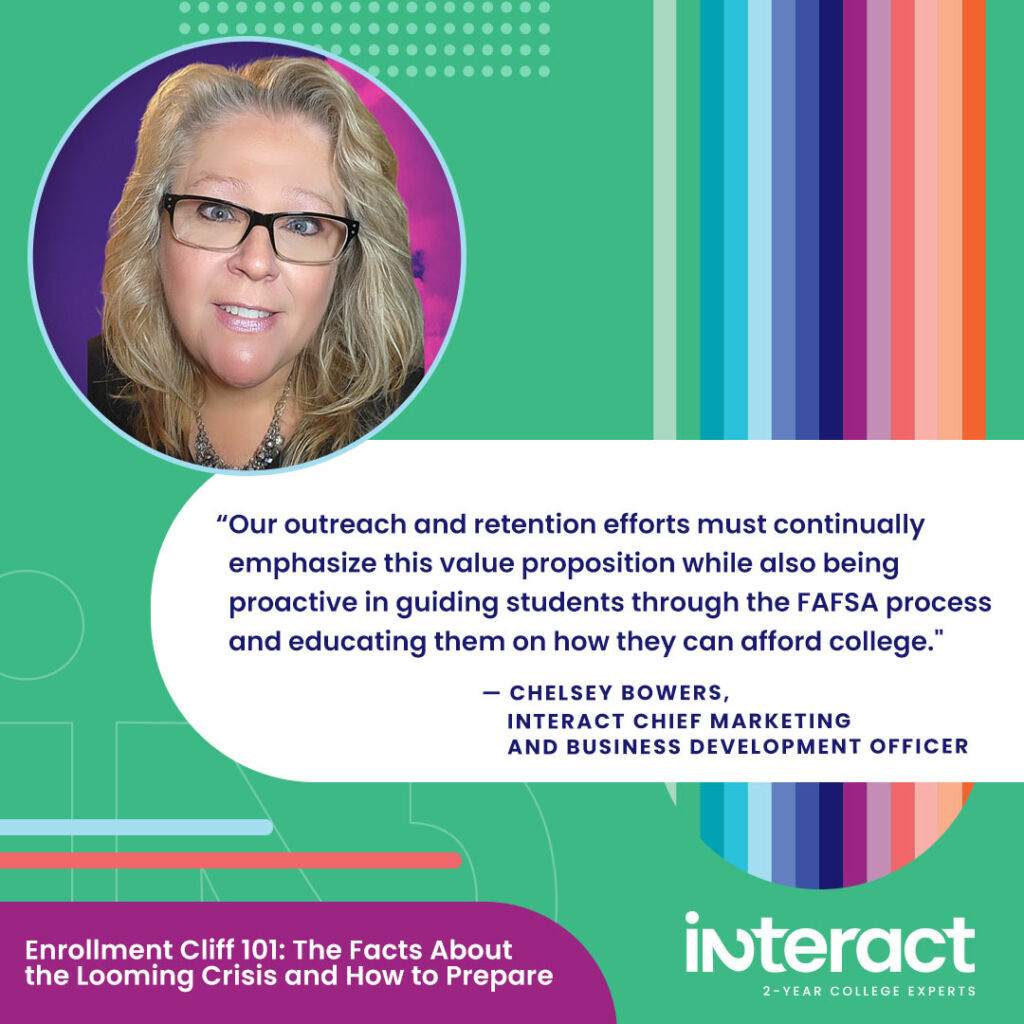
Want to make sure you are dotting all your i’s and crossing all your t’s before the enrollment cliff hits? Here are some suggestions:
Top 5 Ways Your College Can Navigate the Enrollment Cliff
1. Address Students’ Top Pain Point
From Interact’s research, we know students’ major pain point is having enough money to attend college. Many of our students work while attending school and require financial aid and flexible schedules to make it to class.
- Do your students need help filling out the FAFSA? Creating extra awareness and support around ensuring students receive the best financial aid package is key!
- Can your foundation help raise money for increased scholarship opportunities?
- Does your college offer flexible payment plans?
- Are you excluding students from registering for classes if they owe a payment? Try adjusting your policy. Our research shows that financial holds often result in students stopping out. Instead, create flexible, personalized payment solutions so students can stay in school.
“Most students exit because of financial issues,” explains Walleser. A simple practice is lifting financial holds so students can still register for classes. When she instituted a program like this at her previous college, Walleser saw impressive results: “When we delayed their debt, 80 percent of students were able to come back and stay in college while continuing to pay down their balances.”

Speaking of being flexible, that brings us to our next tip …
2. Flexible Career-Focused Programs to Overcome the Enrollment Cliff
With busy working students juggling many responsibilities, our colleges must offer flexible programs and schedules. And for so many students, the focus is on career-focused, skill-building opportunities with a high ROI in helping them climb the career ladder.
For example, take Kellogg Community College. When KCC started new part-time, cohort-based programs with flexible schedules, enrollment soared. In the new part-time nursing program alone, the college received 55 applications for 24 seats, the first time the nursing program has had a waiting list instead of empty seats for some time. The program is getting applicants from as far away as Detroit, a two-and-a-half-hour drive away!
“Over the years, adult learners probably just determined that they couldn’t commit to the time that was required,” says KCC Vice President for Communications and Advancement Eric Greene. “Now that we have modified and customized something for that group, they are showing up.”
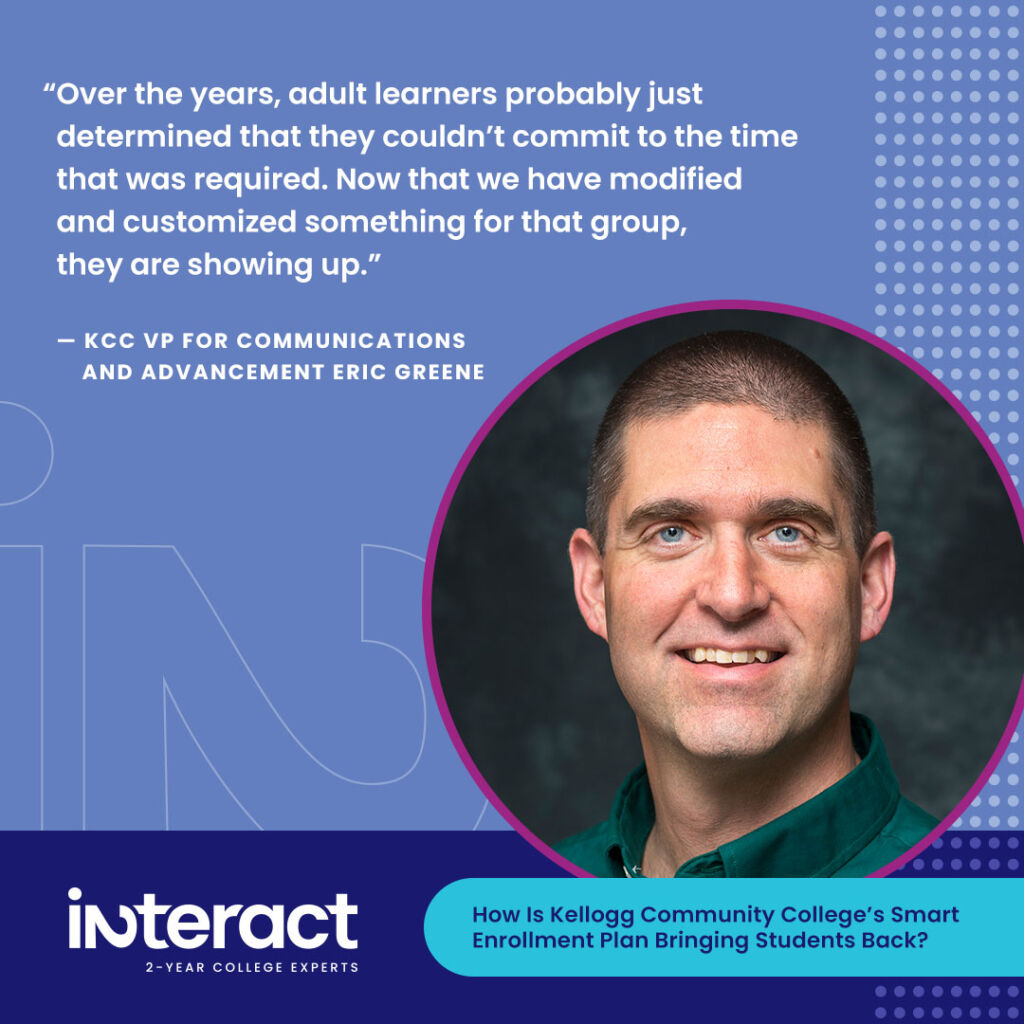
Consider the following:
- Does your college offer accelerated programs?
- Are there plenty of night and weekend classes available?
- Do you offer robust hybrid and online class options?
- Does your college offer plenty of shorter-term, stackable awards to help break down the degree process?
Providing stackable certificates and degrees can be key to helping students and your enrollment:
3. Stackable Awards
Earning an entire college degree can seem overwhelming, especially for nontraditional or underrepresented students. But, break down that big degree into small, manageable segments, and suddenly, students have a can-do attitude.
“Short-term credentials are acting as an on-ramp to a degree for many students in community colleges,” reads the Inside Higher Ed article Stacking Certificates and Degrees. “Findings from several states suggest that approximately 32 to 43 percent of certificate earners are re-enrolling in college and stacking credentials.”
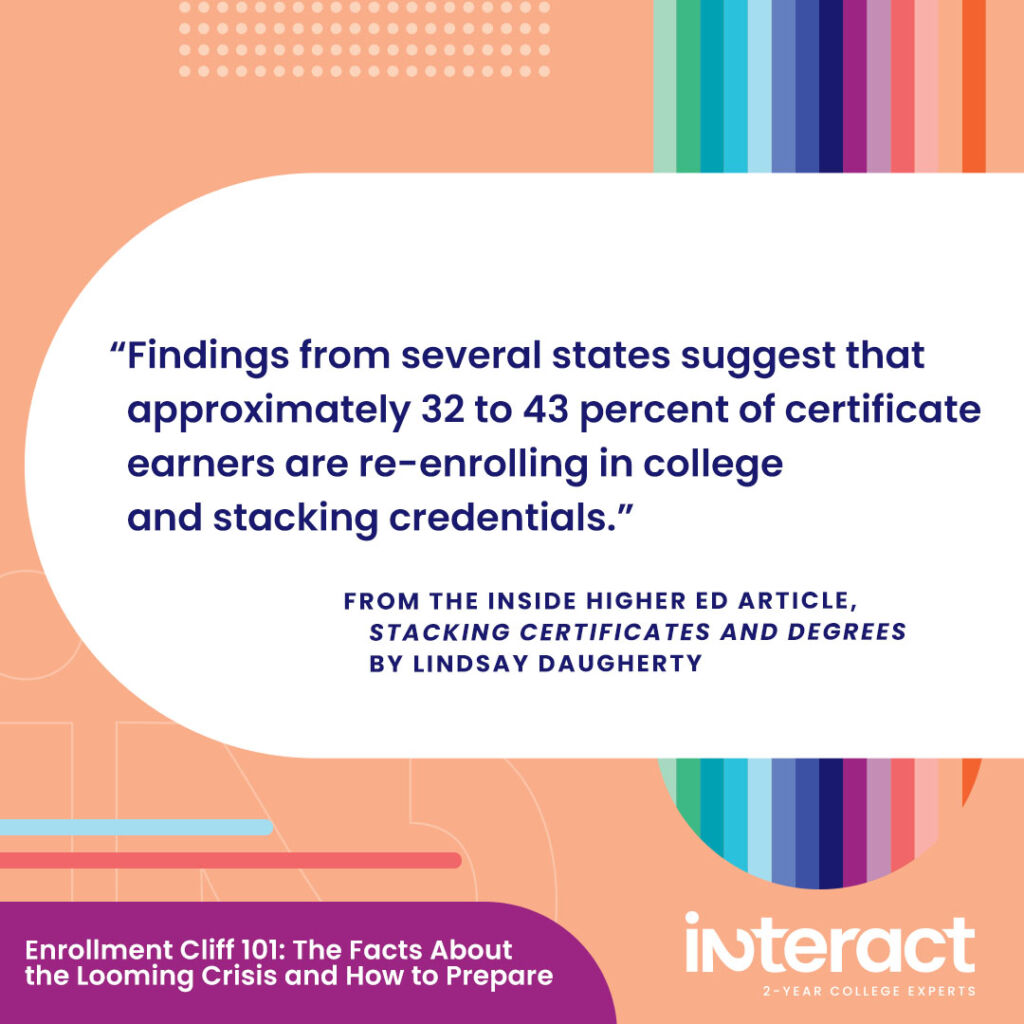
The best part? Many students who stack credentials will go on to earn a full degree.
“Our for-profit competitors are very good at onboarding students and starting coursework every month,” says Walleser. “They have extremely flexible models, so community colleges need to consider offering more short-term options.”
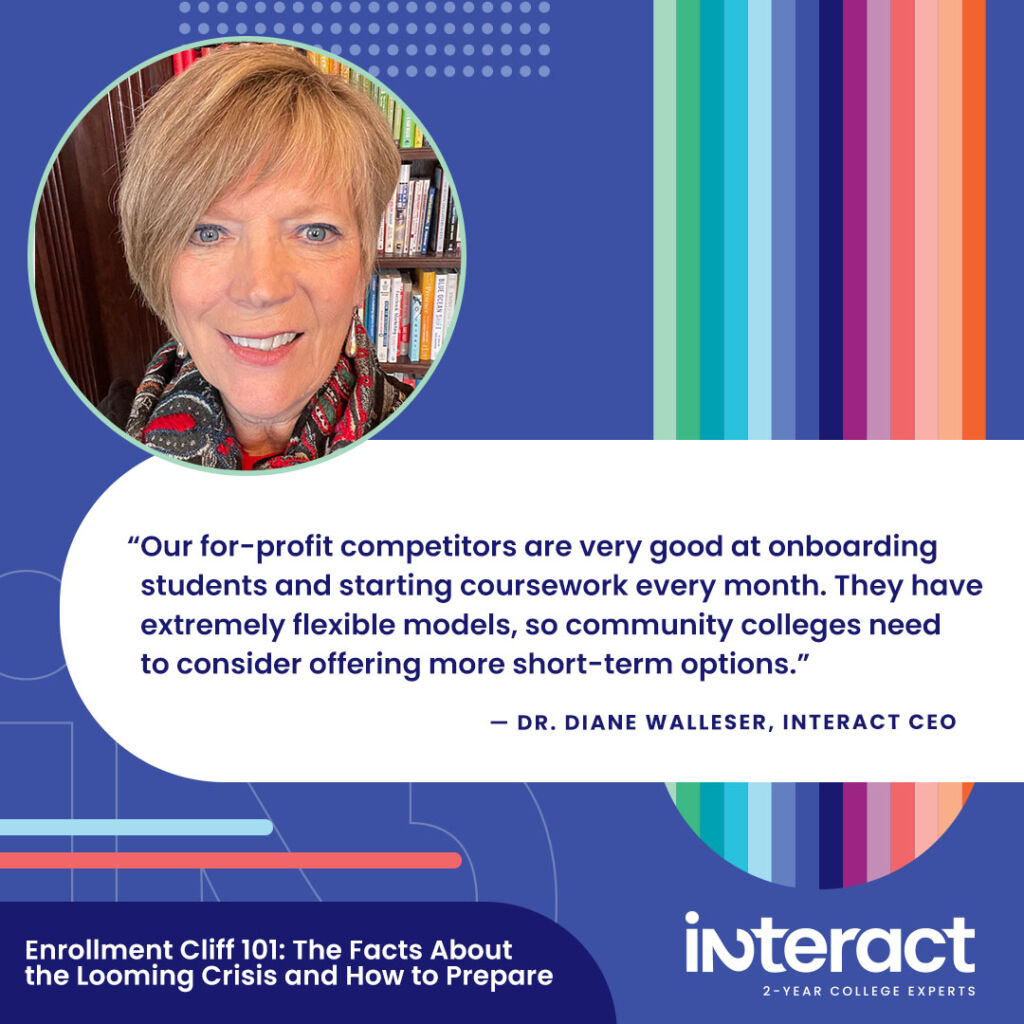
4. Go After Your Stop-Outs Like God’s Own Thunder
“Go after your stop-outs like God’s own thunder year-round,” advises our founder, Dr. Pam Cox-Otto.
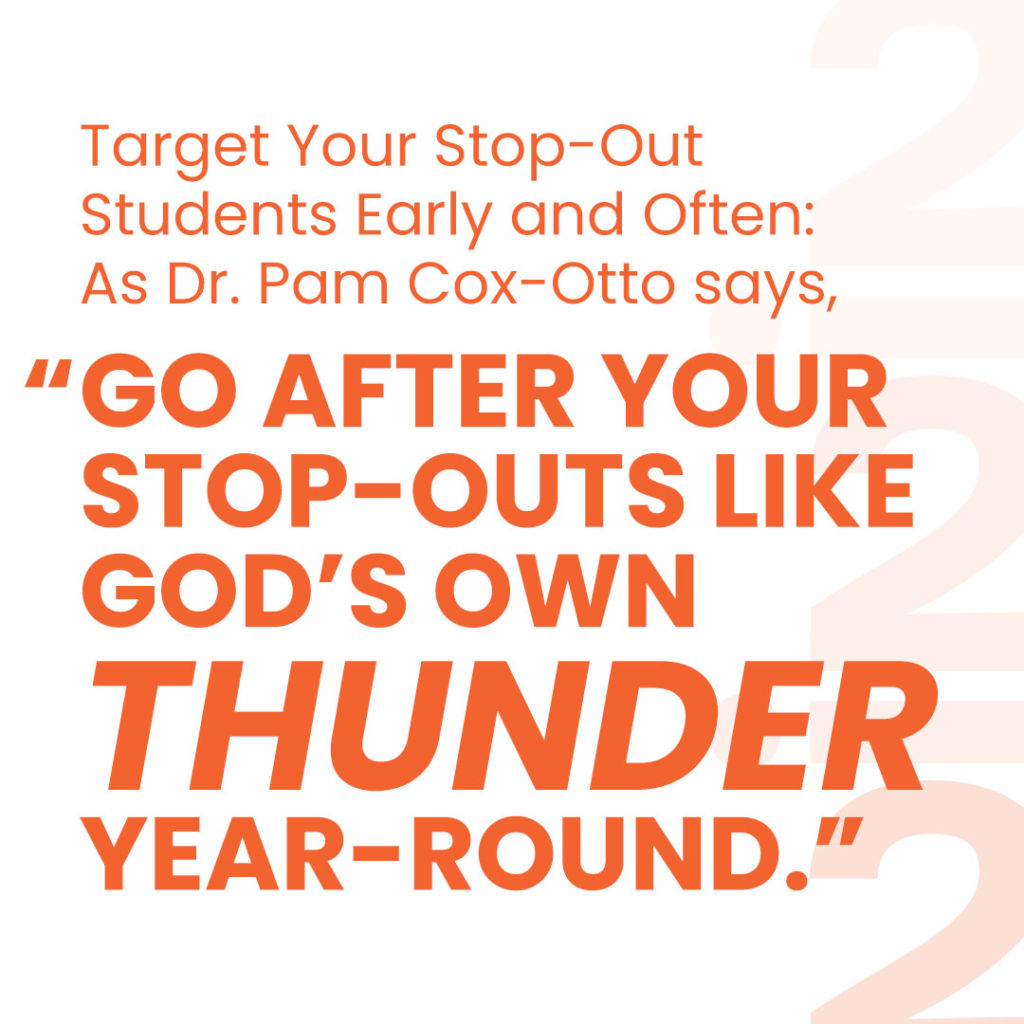
Stop-outs are the single largest audience that you could go after. And they are also the demographic that can make the quickest decision to return. Our research shows that the typical community college loses students at a rate of about 50% or higher, so your stop-out audience will only continue to grow.
As Cox-Otto says, “It’s the largest part of your enrollment, and frankly, it’s the place where you can get the quickest results.”
[For more, read 9 Powerful Tips to Stop Churning and Start Returning Stop-Out Students]5. Retention, Retention, Retention for Enrollment Cliff Prevention
Speaking of stop-outs, how about ensuring you don’t lose students in the first place? From our research, one of the biggest gaps where we lose students is over breaks. Community colleges lose as many as 60% of current students over the summer. But winter break is the second biggest loss, with as many as 35% of students stopping out.
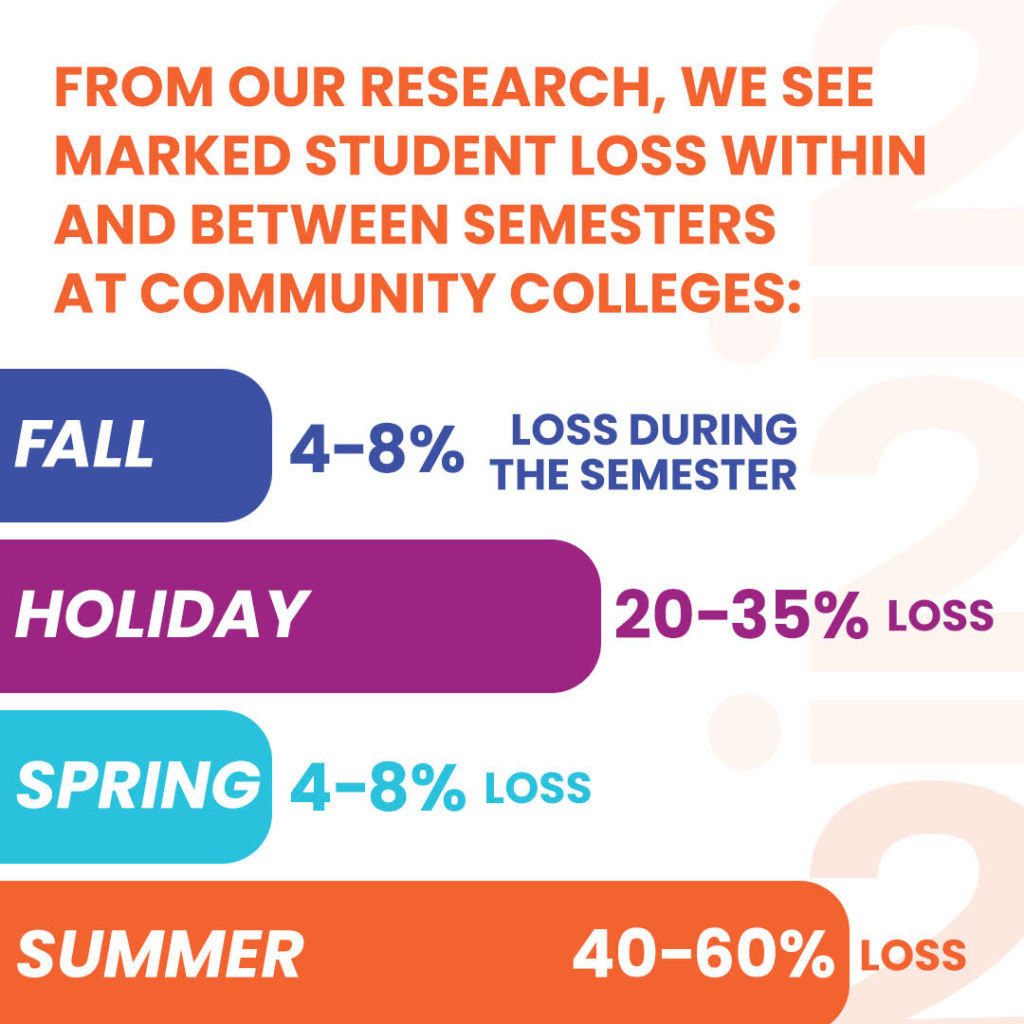
With the enrollment cliff, we know we need to make every student count. How can we ramp up retention efforts before and during these breaks?
Here are some retention ideas:
- Have your faculty set aside 20 minutes during their last class of the semester to have students register for next semester. And give faculty members some talking points to share during class and through your learning management system to encourage students to sign up.
- Send out plenty of reminders before break to register for classes, along with helpful contact information for assistance. Send out messaging on multiple channels to ensure you are reaching all students by email, text, social media, and even flyers on campus.
- Keep motivating your current students with messaging over the holiday break! Congratulate them on how far they’ve come, celebrate their wins, and remind them that finishing a college degree will help them achieve their goals.
“When we asked students about motivational messages, 31% said they do not get enough, which is significant,” says our CEO, Dr. Diane Walleser. Commend students on their achievements, build their confidence, and reinforce that they are closer to their goals. As our CEO says, “We have to continue to keep their eye on the prize.”
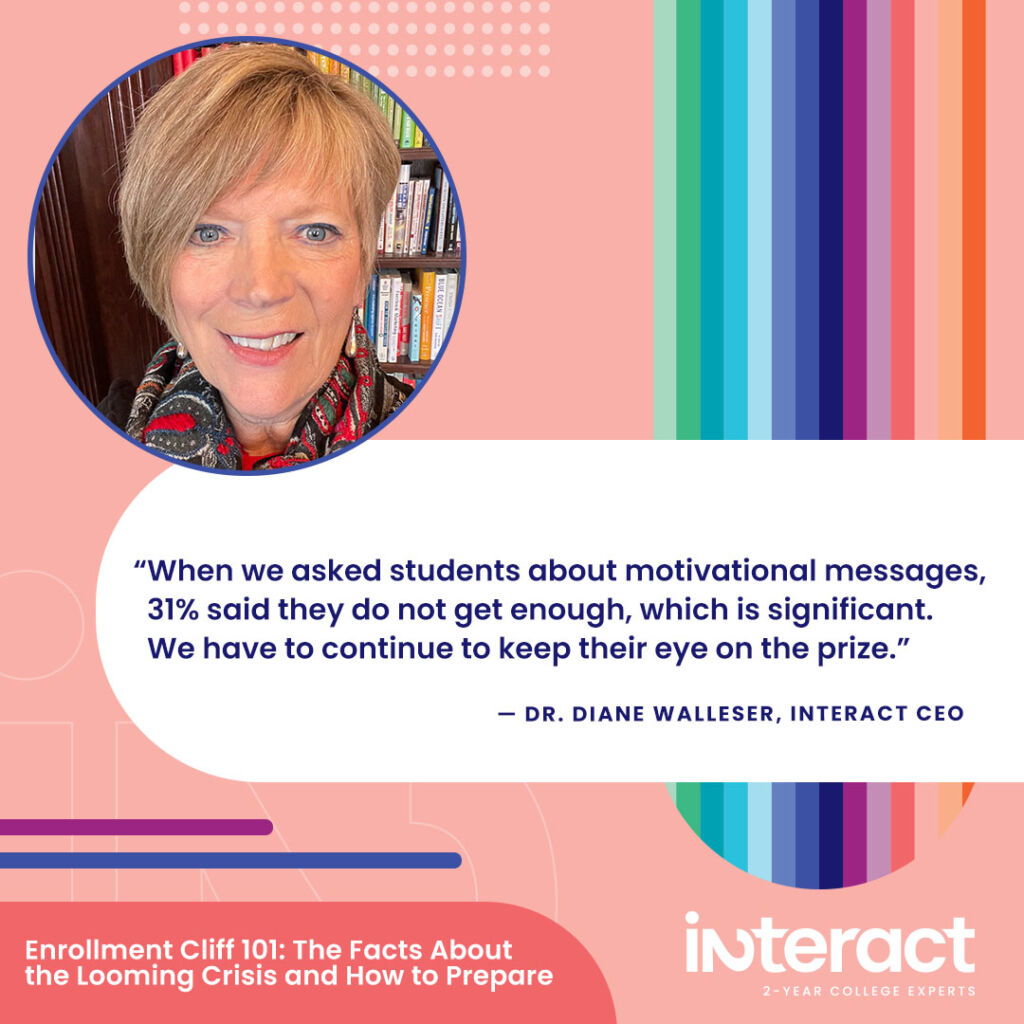
We all know about summer melt, but “melt” between semesters and after breaks is real. For more evergreen tips to freeze melt all year round, check out How to Increase Student Enrollment, with Secrets to Beat Summer Melt.
6. Go After Nontraditional Audiences and Prove Your Workforce ROI
With so many students entering the workforce early and returning to college later in life, developing career advancement programs is key. When colleges align with workforce development, the proof is in students’ career successes. So be sure your offerings are on the cutting edge:
- When did you last assess your program offerings against the latest labor market data?
- Do you have a good way of tracking student career success from your programs? Remember, your audiences are increasingly wanting proof of ROI. From keeping your pulse on success stats to featuring student career success stories, ensure prospects know your college is the smart career choice.
- Are you aligned with nontraditional prospects’ media preferences, including how and where they consume content? If you don’t know the best way to reach nontraditional prospects, they won’t know your programs exist! Interact’s Media Prefs is a great way to reach the right audiences on the right channels at the right times.
Enrollment Cliff Conclusion
Community colleges’ superpowers are flexibility, accessibility, and career readiness. So, be sure to prove your ROI in your outreach, retention messaging, and, most of all, the world-class programs you offer students.
“At Interact, we understand the unique challenges community colleges face, especially during times of uncertainty like the enrollment cliff,” says our chief marketing and business development officer. “You don’t have to navigate this alone. Our team is here to support you with tailored strategies, innovative marketing solutions, and expert guidance to ensure your institution continues to thrive and meet the evolving needs of your students.”

Want help in your corner to survive and thrive during the enrollment cliff? Reach out today for a free consultation, and we can help you innovate solutions!



